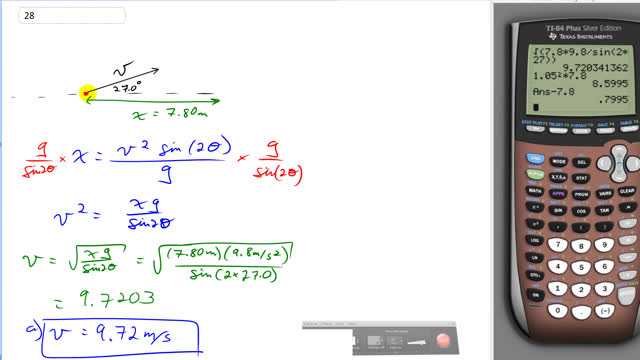
An athlete performing a long jump leaves the ground at a angle and lands 7.80 m away.
- What was the takeoff speed?
- If this speed were increased by just 5.0%, how much longer would the jump be?

In order to watch this solution you need to have a subscription.
This is Giancoli Answers with Mr. Dychko. Knowing the range of this long-jumper is 7.8 meters and knowing the angle of their launch velocity is 27 degrees, we can figure out their launch speed using the range formula. So we have range is their launch speed squared times sin of 2 times the launch angle divided by acceleration due to gravity and we'll multiply both sides by g over sin 2Θ and then it cancels on the right and ends up on the left then multiply by x switch the sides around so we have the unknown v on the left side take the square root of both sides and we get the launch speed then is square root of 7.8 times 9.8 divided by sin of 2 times the angle 27 degrees to give 9.72 meters per second is the launch speed. Now we are asked to consider if their speed was increased by 5 percent, by how much would the range increase? So the range in the second case after the speed is increased to some speed v 2, the range will be v 2 squared times sin 2Θ over g and the original range x 1 which is 7.8 was the original speed which we just found 9.72 let's that v 1 square that times sin 2Θ over g. And now there's a connection between these two because the only difference between them is their speeds and we can relate the speeds because we know that v 2 is 5 percent more than v 1 so we have v 2 is v 1 plus 0.05 times v 1 which is 1.05 times v 1 and so we'll substitute that in for v 2 here. So instead of writing v 2 in this formula for x 2 I'm writing 1 times v 1 and then that result gets squared and so you can apply the exponent to both factors inside the bracket and we get 1.05 squared times v 1 squared times sin 2Θ over g but this whole thing is x 1 so that means x 2 equals 1.05 squared times x 1; in other words, the next range is well is the factor by which the velocities differ squared times the original range. Anyway, hopefully you are following the algebra there and so we have x 2 is 1.05 squared times 7.8 meters which is 8.5995 meters and so the increase in the range is the new range minus the old range which is now 0.8 meters further. And the percent increase is this absolute increase—the number of meters by which it increases—divided by the original amount 7.8 which gives us a percent increase of about 10 percent.